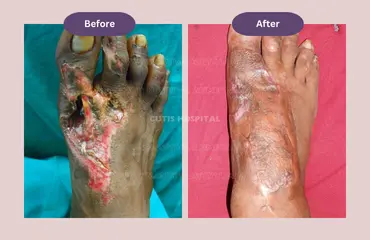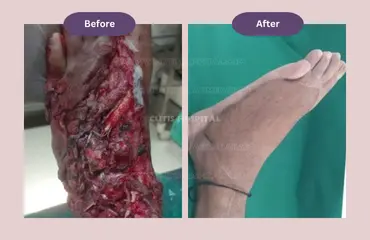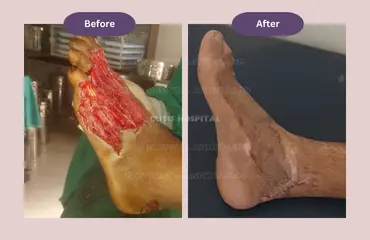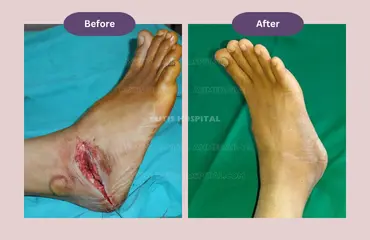Lower limb injuries can happen in domestic settings, in industries, in road traffic accidents, or during sports. Domestic accidents are usually minor and range from abrasions, lacerations, nail avulsions, or fractures of toes. However, burns and scalds happening to small children at home can sometimes account for major injuries. Industrial accidents of the lower limbs can range over a wide spectrum. Minor injuries to toes to traumatic amputation of lower limbs are not uncommon injuries happening in industries. The same is true for road traffic accidents.
Fractures of the long bones of the lower limbs are quite common in motorbike accidents. While car accidents and run-over accidents present variably as crush, avulsion, or degloving injuries, or a combination thereof. Sports injuries of the lower limbs are mainly ligament injuries, sprains, and sometimes closed fractures.
Symptoms of lower limb injuries include pain, deformity of limb, swelling, redness, bleeding from the wound in open injuries, inability to move the toes or foot, loss of sensations, blackening of toes, foot or sometimes leg, chronic swelling not responsive to treatment, pigmentation, shortening of limb or many such presentations. Lower limb injuries can have either one or combination of above symptoms.
Lower limb injury is diagnosed by thorough history, physical examination and investigations. History of an accident is very important as it provides the clue towards injured structures and their assessment. Physical examination of lower limb injury patient must be in detail; particularly functions of individual muscles, nerves (both motor and sensory) and pulsations of major arteries must be checked. Condition of the skin overlying the fracture site must be examined and noted in detail. After clinical examination, supportive investigations like X – ray of local part and sometimes CT scan plays a vital role.
In complex soft tissue injuries, MRI is an indispensable investigation. Blood flow within the arteries and veins can be confirmed by color doppler study of blood vessels and functions of nerves can be checked by electromyography (EMG) and nerve conduction velocity (NCV) studies.
Treatment of lower limb injuries must begin as early as possible after the injury. Temporary stabilization of a fractured / injured lower limb is very important part of treatment even before reaching the hospital. Once patient arrives at the hospital, thorough physical examination is carried out and simultaneous systemic stabilization is achieved with supportive treatment in the form of intravenous fluids, antibiotics, painkillers, general nursing care and splints. Definitive treatment of lower limb injuries must involve an experienced and qualified plastic surgeon form the presentation of the patient.
Except for some closed long bone fractures and ligament injuries of lower limbs, plastic surgeons and his/her skills are essential for all patients with burns, electrical injuries, tendon injuries, nerve injuries, muscle injuries, deep abrasions of skin, skin loss, compound tissue loss with or without fractures and amputations.
Complications of lower limb injuries include infection (cellulitis), wound gap, nonunion of fracture, mal union of fracture, infection of bone (osteomyelitis), exposed bone or fracture site, exposed implant, dehiscence of tendon, skin necrosis, persistent swelling, gangrene of one or multiple toes.
Taking all safety precautions at home, and in industries, and following all safety traffic rules are the basic and most essential preventive measures. However, even after following all safety measures accidents are bound to happen albeit to a lesser extent and of lesser magnitude. Once the accident happens, where to shift the patient of lower limb injury becomes the most important question to answer. A hospital where round the clock services of a qualified plastic surgeon are available is the best place to shift such patients. Because, initial evaluation and formulation of a long term management strategy of lower limb injuries by a qualified plastic surgeon is the best approach to get optimum functional and aesthetic results.
The results of lower limb injuries are usually good in young patients and children. Results of sharp injuries and uncomplicated fractures are also good. However, crush, avulsion, degloving injuries of lower limbs, injuries in limbs with arterial insufficiency, electrical injuries, major nerve injuries, traumatic amputations, and compound tissue losses do not always have good results.
At Cutis Hospital, all patients with lower limb injuries are examined primarily by a qualified and experienced plastic surgeon who has vast experience in dealing with such injuries as well as experience working in close association with good orthopedic surgeons for a long time. Lower limb injury patients are not explained about the importance of elevation of the limb and having rest during critical times of limb edema.
At Cutis Hospital, we counsel every patient of lower limb injuries and the importance of rest and limb elevation is emphasized to them. Special counseling and extensive moral support are provided for patients who require prolonged bed rest and multi-staged treatment.





Yes, it is necessary to elevate the limb and rest after lower limb injuries. Because any injury anywhere leads to inflammation and secondary edema. The lower limb, which is always in a dependent position, tends to develop and retain more edema than other body parts. If the patient has chronic insufficiency of arteries or veins or preexisting edema, this can complicate the edema and may lead to the development of infection (cellulitis). So, to rest and elevate the injured lower limb till the healing process has progressed to a satisfactory level is an extremely essential part of the treatment.
Dressing in soft tissue injuries of the lower limb is a very important aspect of the treatment because proper care of the wound right from the presentation of the patient to the time all wounds heal is essential to prevent secondary infection. Splinting the joints of lower limbs in anatomical position and giving them rest is equally supporting for the healing process. Once the healing process is completed and tissues develop maturity, the patient is allowed to remain without dressing and splintage for increasing periods of time.
Before repairing any injury anywhere in the lower limb or whole body, the Plastic surgeon does the debridement of the tissues (preferably) under magnification. Debridement of the injured tissues in lower limb injury means the removal of foreign bodies, dead, necrotic, and potentially contaminated tissues under tourniquet control (controlled situation without bleeding) and with magnification. Perfect debridement is the key to definitive repair and long-term good results without complications.
Tissue losses in the lower limb injuries can be variable starting from skin loss, loss of skin and subcutaneous tissues, muscle loss, loss of nerves and blood vessels and loss of significant length of bones of lower limbs. Plastic surgery is a wonderful discipline of science which has different options of coverage for different types of tissue losses. Skin grafting, local tissue flaps, muscle flaps, musculocutaneous flaps, pedicled flaps and microvascular tissue transfer are some of the excellent means of plastic surgical techniques to replace the losses and cover the defects in lower limb injuries.
Yes, long term follow up is necessary for lower limb injuries like burns, electrical injuries, crush injuries, complex fractures, nerve injuries and vascular injuries.
Additional medical treatments like physiotherapy, range of motion exercises, splinting, pressure garments, muscle and nerve stimulation and scar treatment are essential measures in all major lower limb injuries. They improve the healing process, greatly modify the quality of life of the patient and help the patient to get back to his life (rehabilitation).
Cutis Hospital is conveniently located in Ghatlodia, Ahmedabad, making it easily accessible via multiple modes of transportation. Below are the various ways you can reach our facility:
Sardar Vallabhbhai Patel International Airport: Located approximately 12.7 km from Cutis Hospital, offering convenient access for patients traveling from outside the city.
Chandlodiya Railway Station: Approximately 2.4 km from Cutis Hospital.
Ahmedabad Railway Station: Around 11 km from our center.
GSRTC:
Ahmedabad Central Bus Station (GSRTC): About 10.3 km from the hospital.
AMTS:
Bhuyangdev Cross Road Bus Stop: Just 500 meters from Cutis Hospital.
BRTS:
Bhuyangdev BRTS Bus Stop: Only 170 meters from our center.
We provide effective surgical and non-surgical treatments for all parts of the body. At Cutis Hospital, our cosmetic and plastic surgery team is committed to giving patients safe and high-quality care.